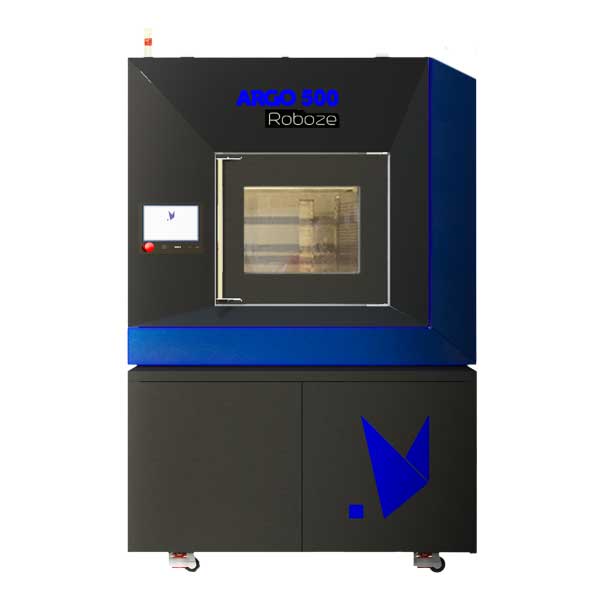The University of Delaware has selected the Roboze ARGO 500 3D printer to facilitate collaborative research of high temperature composite 3D printing with the US Army.
The University’s Center for Composite Materials (CCM) aims to use the industrial FFF system to expand its own research while accelerating the manufacturing of finished parts and mission-critical components for the US defence unit.
The Roboze ARGO 500
CCM chose the ARGO 500 due to its high precision and reliability, even when fabricating parts made of super polymers and composite materials such as PEEK and carbon fiber. The system is also optimized with a number of automated processes that make it faster than many other FFF systems currently available. The CCM will be supporting the Combat Capabilities Development Center US Army Research Laboratory on Additive Manufacturing (CCDC)’s need for specialist, precise, and durable parts with the printer’s high-end capabilities.

Larry Holmes Jr., Assistant Director, Digital Design and Additive Manufacturing at UD-Center for Composite Materials, states: “Roboze ARGO 500 was selected for our collaborative efforts. We are especially concerned with repeatability and accuracy, and the ARGO 500 helical rack and pinion hardware (beltless system) can help us provide these qualities. We also required the ability to print high performance materials and require a broad range of thermal profiles to do so. The ARGO 500 can print all of the materials of interest, from standard FFF materials to fiber reinforced high temperature thermoplastics.”
He adds, “We also want to assure stability of prints when using high temperature materials, so we need to ensure we have control of the build chamber temperature, and the ARGO promises to give us that control. The automatic build plate leveling system and vacuum system within the ARGO were also important aspects in the selection of this equipment.”
Collaborative research efforts
There are two main focus areas of the research program between the CCM and the CCDC. The first is concerned with developing a modeling and simulation tool to help accelerate the adoption of 3D printed components in the US Army. The software will use material and process information from the ARGO 500 to help the defence unit’s design engineers quickly select design options while allowing the engineers to optimize performance for particular use cases. The Department of Defence (DoD) has expressed interest in inserting AM parts into its logistics chains but the certification and qualification process has proven slow and costly. The University believes that this tool will aid in the acceptance of AM parts by optimizing the virtual design stage, with information incorporated straight from the ARGO 500.
The second area of focus is on physical part fabrication. The University will be working directly with the US Army’s engineering personnel to design and manufacture components for ground and air systems. The ARGO 500 is expected to shine in this area, with rapid and low cost mission specific vehicle part fabrication.
“While we are working to assist in mainstream acceptance of AM in DoD supply chains, there are some missions that have a less rigorous pathway to fielded use. One such case could be unmanned or autonomous vehicles,” explains Larry Holmes.

John Gerdes, Ph.D., Team Lead Technology Development & Transition at Vehicle Applied Research Division, US Army Research Laboratory, adds, “The Army needs to reduce logistics burdens and find ways to be adaptive to rapidly changing mission needs. Additive manufacturing can meet these needs, but must also offer parts with the durability and dependability that are demanded by soldiers who rely on their equipment to accomplish critical missions.”
Furthermore, the University intends to use the ARGO 500 as a teaching and research tool for its staff and students.
The US Army is not the only division of the defense sector employing additive manufacturing. The US Marine Corps has previously explored concrete 3D printing by using a new continuous mixer and a three-inch print nozzle to additively manufacture multiple structures, such as barracks and a bridge.
Medical devices in the US military have also seen a 3D printed upgrade. An experiment conducted by the Uniformed Services University of the Health Sciences (USU) and the U.S. Military Academy West Point showed that it is possible to 3D print and rapidly deploy a range of medical devices to treat those injured on the battlefield.
The nominations for the 2020 3D Printing Industry Awards are now open. Who do you think should make the shortlists for this year’s show? Have your say now.
Subscribe to the 3D Printing Industry newsletter for the latest news in additive manufacturing. You can also stay connected by following us on Twitter and liking us on Facebook.
Looking for a career in additive manufacturing? Visit 3D Printing Jobs for a selection of roles in the industry.
Featured image shows Roboze ARGO 500 3D printer. Photo via Roboze.


